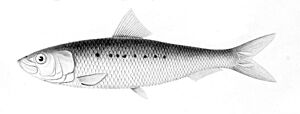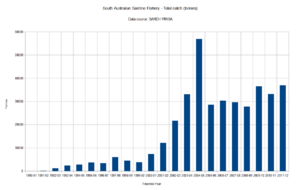Southern bluefin tuna facts for kids
Quick facts for kids Southern bluefin tuna |
|
|---|---|
 |
|
| Conservation status | |
| Scientific classification | |
| Synonyms | |
|
The southern bluefin tuna (Thunnus maccoyii) is a large tuna that lives in the open waters of the southern Hemisphere. You can find them mainly between 30°S and 50°S latitude, sometimes even closer to 60°S. These amazing fish can grow up to 2.5 meters (8.2 ft) long and weigh as much as 260 kilograms (573 lb). This makes them one of the biggest bony fish in the ocean!
Southern bluefin tuna are like other tuna species that live in the open ocean. They are special because they can keep their body temperature warmer than the water around them. They can be about 10°C (18°F) warmer! This helps them stay active and hunt for food, even when the water is cold. They eat many different things, like fish, crabs and shrimp, cephalopods (like squid), and other sea creatures.
Contents
How Southern Bluefin Tuna Live
Southern bluefin tuna are active hunters and need a lot of energy. They live in the open ocean but can dive very deep, sometimes up to 2,500 meters (8,200 ft)! They also travel long distances between warm tropical waters and cooler areas to find food. For example, they migrate between the waters off Australia and the Indian Ocean.
Even though they like water temperatures between 18-20°C (64-68°F), they can handle much colder water (as low as 3°C / 37°F) when diving deep. They can also survive in warmer water (up to 30°C / 86°F) when they are spawning (laying eggs).
Breathing and Body Heat
Changing temperatures and depths are a big challenge for these fish. Tuna swim all the time and very fast, so they need a lot of oxygen. Water has less oxygen when it's warmer. But tuna follow their food, not just the water temperature.
Unlike most fish, bluefin tuna can keep their swimming muscles at a steady temperature. This means they are not only warm-blooded (endothermic) but also good at controlling their body heat (thermoregulators). Sadly, the southern bluefin tuna is listed as critically endangered. This means it's at a very high risk of becoming extinct.
How Their Bodies Work
Southern bluefin tuna have special bodies that help them survive.
How They Breathe
Tuna breathe in a unique way because they need so much oxygen. They are "ram ventilators." This means they have to keep swimming with their mouths open to push water over their gills. The water goes into their mouth, over their gills, and then out.
Most fish use a special pump to move water over their gills. But tuna don't need this pump. If a tuna stops swimming, it can't breathe and will suffocate. This is because their bodies are designed for constant, fast movement.
When a tuna swims faster, more water flows over its gills. This helps it take in more oxygen. Also, since they don't use energy to pump water, they can use that energy for their powerful swimming muscles.
Tuna gills are very special. They have a huge surface area, much larger than other fish. This big area helps them take in oxygen very quickly. Their gills also have a very thin membrane. This means oxygen doesn't have far to travel to get into their blood. Tuna can use 50-60% of the oxygen in the water, which is much more than other fish. All these features help them get enough oxygen for their active lives.
How Their Blood Moves
Tuna hearts are very big, much larger than other active fish. Their hearts have four chambers, just like other bony fish. The heart pumps blood to the gills and then to the rest of the body.
Tuna have strong, thick-walled hearts that can pump blood very quickly. Their heart muscles are full of tiny blood vessels. This helps them get a lot of oxygen and nutrients.
Their main arteries and veins run along their spine, near their red swimming muscles. Small arteries branch off to deliver oxygen-rich blood to these muscles. Veins carry oxygen-poor blood back to the heart. These blood vessels are arranged in a special way called a "rete mirabile." This allows them to keep the heat produced by their muscles inside their bodies.
Tuna have the highest blood pressure among all fish. They also have a very fast heart rate. To pump so much blood, their hearts beat faster. Their heart rate can reach up to 200 beats per minute in normal temperatures!
Tuna blood has a lot of hemoglobin. Hemoglobin is what carries oxygen in the blood. This means their blood can carry a lot of oxygen to their muscles and other body parts.
How Breathing and Blood Work Together
Tuna are some of the most active fish in the ocean. They need super-efficient breathing and blood systems.
Their breathing system is great at taking oxygen from the water quickly. They use "ram ventilation" to push huge amounts of water over their gills. Their gills are also specially designed to let oxygen spread fast.
Their blood system works with the breathing system to move oxygen to their body parts quickly. They have a lot of hemoglobin, so their blood carries a lot of oxygen. Their big hearts pump blood very fast. All these features help southern bluefin tuna get oxygen quickly and save energy for their active lifestyle.
How They Balance Salt and Water
Southern bluefin tuna live in salty ocean water. Like other marine fish, they need to keep a steady amount of salt and water inside their bodies. This is called "osmoregulation."
The fluids inside a tuna's body are less salty than the ocean water. This means water naturally wants to leave their bodies, and salt wants to come in. To stop this, tuna drink seawater. Then, they have special ways to get rid of the extra salt.
Their gills are very important for getting rid of salt. They have special cells called "ionocytes" that pump salt out of their bodies. Their kidneys also help by getting rid of certain salts, like magnesium. This helps them keep their internal salt and water levels just right.
Controlling Body Temperature
Southern bluefin tuna are amazing at controlling their body temperature.
Challenges of Temperature Change
These tuna can dive from the warm surface to depths of 1,000 meters (3,280 ft) in just a few minutes. They hunt in cool waters during winter and travel to warm tropical areas to spawn. They prefer temperatures around 18-20°C (64-68°F), but they can handle water as cold as 2.6°C (37°F) and as warm as 30.4°C (87°F).
Tuna are "endotherms," meaning they can keep their body temperature higher than the surrounding water. This is hard to do in water, but it helps them be more active and hunt in colder places. They have special fatty tissues and muscles that help keep heat inside.
How They Control Temperature
Tuna use special blood vessel networks called "rete mirabile" to control their body heat. These networks act like heat exchangers. They keep the heat produced by the muscles inside the body and stop it from escaping through the gills.
When tuna dive into cold water, their bodies direct more blood to these heat-saving networks. When they are in warmer water, they can send less blood to these networks to cool down. This helps them keep their body temperature stable.
Their hearts and livers are usually colder than their swimming muscles. The tuna's blood is special because it can still carry oxygen well, even with these temperature differences. This helps ensure all parts of their body get enough oxygen.
The tuna's heart also works harder in colder water. It pumps warm blood to the muscles faster to keep them warm.
Their eyes and brain also stay warm, often 15-20°C (27-36°F) warmer than the water. This helps them see better and react faster when hunting.
Fishing for Southern Bluefin Tuna
Many countries fish for southern bluefin tuna. Since the 1950s, new technologies like GPS and fish finders have made it easier to catch them. This has led to a big drop in their numbers. In the 1960s, about 80,000 tons were caught each year. By 1980, it was down to 40,000 tons. The total population has dropped by about 92 percent.
Rules for Fishing
In 1994, countries like Australia, New Zealand, and Japan created the Commission for the Conservation of Southern Bluefin Tuna (CCSBT). Their goal is to protect the tuna and manage fishing. Other countries like South Korea, Taiwan, Indonesia, and the European Union have also joined.
The CCSBT sets limits on how many tuna can be caught each year. These limits are called "Total Allowable Catch" (TAC). In 2010, the global catch limit was reduced to help the tuna population recover. Australia usually has the highest catch limit.
The quota system has made tuna more valuable. Fishermen now earn more money selling tuna for the Japanese market.
Fun Fishing
People also fish for southern bluefin tuna for fun, especially in Australia. There are rules about how many fish you can catch.
Several fishing competitions are held each year. For example, in 2015, the Coast 2 Coast Tuna Tournament had 165 people and 54 boats. They weighed in almost 2,500 kg (5,500 lb) of tuna!
Tuna Farming (Aquaculture)
Because wild tuna numbers are dropping, some people are trying to "farm" tuna. This is called "ranching." Most southern bluefin tuna ranching happens near Port Lincoln, South Australia. This area has been important for tuna fishing since the 1970s.
How Tuna are Farmed
Southern bluefin tuna lay their eggs between September and April in the Indian Ocean. The eggs hatch quickly, and the young tuna grow to about 15 kilograms (33 lb) in two years. These young tuna are caught by fishermen.
The young tuna are caught using large nets and then moved into special floating pens. These pens are towed slowly back to farm areas near Port Lincoln. This can take several weeks. Once at the farm, the tuna are moved into bigger pens, about 40-50 meters (130-160 ft) wide.
They are fed small fish, like sardines, twice a day, six days a week. They stay in these pens for three to eight months, growing to an average of 30-40 kilograms (66-88 lb). Tuna swim very fast and need a lot of space, so keeping them in pens is tricky.
Farming tuna is expensive, especially the food. Scientists are trying to find cheaper food that doesn't change the taste of the tuna.
When the tuna are ready, they are gently guided into a boat, killed, and quickly frozen. Most are then flown to Tokyo, Japan. A single pen with 2,000 tuna can be worth around $2 million! Australia exports about 10,000 metric tons of southern bluefin tuna each year, mostly from farmed fish.
The southern bluefin tuna farming industry is worth a lot of money to South Australia. It was worth $290 million in 2004.
Tuna Food and Health
Scientists are working to create better and cheaper food for farmed tuna. Right now, they mostly eat fresh or frozen small fish like sardines. It takes about 15 kg (33 lb) of live fish for a tuna to gain 1 kg (2.2 lb) of fat.
Adding vitamins like E and C to their diet can help the tuna meat stay fresh longer. This is important because the frozen baitfish they eat might not have as many vitamins as wild tuna's natural diet.
Diseases and parasites are not a big problem for farmed tuna. However, low oxygen levels in the water can be an issue, especially if there are algal blooms.
Breeding Tuna in Tanks
For a long time, it was hard to breed tuna in captivity. But in 2007, Australian researchers successfully made tuna spawn in landlocked tanks. This was a big step! They used hormones to help the fish lay eggs. This company, Clean Seas Tuna Limited, was the first to successfully move large tuna to onshore facilities for spawning. Time magazine even called it one of the "World's Best Inventions" in 2009.
They built a special facility for breeding tuna larvae. Even though they've had some success with spawning, growing large numbers of young tuna to market size has been difficult. The company has paused some of its research but hopes to continue in the future.
Eating Southern Bluefin Tuna
Southern bluefin tuna is a very popular and expensive food, especially for sashimi and sushi. It has a medium-flavored meat.
Japan eats the most southern bluefin tuna, followed by the USA and China. The price of bluefin tuna can be very high. In 1990, it was $34 per kilogram. In 2013, a huge Pacific bluefin tuna sold for $1.8 million at the Tsukiji fish market in Tokyo!
The Tsukiji fish market in Tokyo is the biggest market for southern bluefin tuna in the world. They handle thousands of tons of fish every day.
Protecting Southern Bluefin Tuna
The southern bluefin tuna is listed as "Critically Endangered" by the IUCN. This means it's very close to becoming extinct in the wild. In Australia, it's listed as "Conservation Dependent," which allows some fishing to continue.
Many environmental groups, like Greenpeace and the Australian Marine Conservation Society, are worried about southern bluefin tuna fishing and farming. They believe it's not sustainable.
Problems with Tuna Farming
Tuna farms need a lot of feed. It takes about 15 kg (33 lb) of feed to produce 1 kg (2.2 lb) of tuna. This means a lot of smaller fish are caught to feed the tuna. Also, the waste from the farms can pollute the ocean.
Pollution from Farms
Tuna farms release solid waste and dissolved nutrients into the water. This can affect the ocean floor and the water quality. Because tuna have high metabolisms, they don't keep much nitrogen in their bodies, so a lot of nutrients are released into the environment.
The tuna farming industry is the biggest source of nutrient pollution in Spencer Gulf, Australia. Other chemicals, like anti-fouling agents for cages and medicines for fish, can also get into the water.
Sardine Fishing for Feed
Australia's largest fishery (by amount of fish caught) is for sardines. Most of these sardines are used to feed farmed southern bluefin tuna. This raises concerns about how it affects other animals that eat sardines, like seabirds.
The sardine fishery uses large nets that can be up to 1 km (0.6 miles) long. Sometimes, other animals like common dolphins get caught in these nets by accident.
Sharks and Tuna Farms
Tuna cages can attract sharks, especially if fish die in the pens. Sharks might bite holes in the nets or get tangled. When this happens, workers try to get the sharks out or, sometimes, kill them. Great white sharks, which are protected, have been known to interact with tuna farms.
Tuna in Movies and TV
The southern bluefin tuna industry has been featured in several documentary films. These include Tuna Cowboys and Tuna Wranglers, which were made for channels like National Geographic and Discovery Channel. The film Sushi: The Global Catch also shows the efforts to breed southern bluefin tuna in captivity.
- Froese, Rainer and Pauly, Daniel, eds. (2006). "Thunnus maccoyii" in FishBase. March 2006 version.
- Tony Ayling & Geoffrey Cox, Collins Guide to the Sea Fishes of New Zealand, (William Collins Publishers Ltd., Auckland, New Zealand 1982) ISBN: 0-00-216987-8
- Clover, Charles. 2004. The End of the Line: How overfishing is changing the world and what we eat. Ebury Press, London. ISBN: 978-0-09-189780-2
See also
 In Spanish: Atún rojo del sur para niños
In Spanish: Atún rojo del sur para niños







